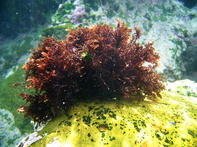Although most beneficial kelp and seaweed species in South Africa are wild-harvested in designated concession areas, some green and red seaweed species may be cultivated, mainly for the supplementary feeding of abalone in abalone farms.

Uses of Kelp
Kelp has been collected from the beach since the early 1950s, mainly for export to the US, Europe and Asia where it is used for alginate production. Alginates are gel-forming and are absorbent, used in applications ranging from natural dressings for wounds to thickeners in food, such as salad dressings and ice cream.
Kelp was cut from seabeds for the production of liquid plant growth stimulants, but with the start of abalone farming in South Africa, the demand for kelp fronds as the natural feed for abalone increased, with the maximum sustained yield reached in 2003.
Kelp heads with fronds are harvested fresh from the surface of the ocean, from boats at low tide. At the abalone farms, it is cut into smaller pieces and fed to abalone. Abalone farms also test feed alternatives and combinations such as kelp, mostly E. maxima, red seaweeds, such as the Gelidium species, green seaweeds, such as Ulva species and formulated feeds with seaweed or fishmeal as the protein source.
Ecklonia, compared to Laminaria, has a lower food conversion ratio (FCR) and is preferred by abalone farmers. This is now supplemented with cultivated Ulva species as well as the red seaweed Gracilaria gracilis.
Beachcast kelp (Ecklonia) is collected, spread out to dry and then milled into smaller pieces, bagged and shipped for alginate production. Dried kelp pellets can also be used as an abalone feed, while powdered kelp is used in Japan for fish-feed.
Kelp contains plant growth hormones and trace elements. These ‘cell juices’ are extracted and used in agriculture and horticulture, to stimulate plant growth. Research on Ulva amoricana also demonstrated its successful use as a plant-growth stimulant in some African leafy vegetables.
Uses of Seaweed
In South Africa, harvesting of the red seaweeds Gracilaria and Gelidium started during World War II. Still, much of the red seaweeds harvested are destined for the alginate market, dominated by large international companies. Gelidium species, mainly G. pristoides are hand-harvested at spring low tide, spread out to dry and then baled and exported, if prices allow.
Agar and carrageenan are two products manufactured from dried red seaweeds. Agar is used as a gelling agent, as a vegetarian alternative to gelatin, a thickener and as a clarifying agent in brewing. Carrageenan is a stabiliser preventing foods, such as almond milk from separating and suspends the nutrients in baby formulas.
Extraction and manufacture of kelp and seaweed end-products are technologically complicated, expensive and influenced by international market pressures, with the result that only plant-growth stimulants from kelp are produced in South Africa at present.
Seaweed is edible and South Africa has a number of species that can be used for consumption, although some taste unpleasant. Seaweeds are a useful source of vitamins, over 90 minerals, trace elements and fibre. Seaweed meal is used as a feed additive, for livestock ranging from sheep and poultry to dogs and cats.
In 1974 the American Gas Association started with research to determine the suitability of kelp for biogas production and various types of kelp and seaweed have been tested. Subsequent research found that biofuels, produced from microalgae and marine macroalgae, (seaweed) are considered to be a viable alternative energy resource.
Cultivating Seaweed
In South Africa, abalone farms in the Eastern Cape depend on on-farm seaweed cultivation for abalone feed as they have no access to fresh kelp. Their seaweeds are successfully grown in the wastewater from the abalone tanks. Mainly Gracilaria gracilis and Ulva species have been used for experimental seaweed farming. One of the Eastern Cape farms could meet 60% of its feed requirement from cultured Gracillaria and Ulva.
Integrated cultivation of seaweed and abalone has long been suggested and is in commercial operation. This has reduced the dependence on kelp, artificial food and energy, reduced the build-up of waste products in the water and increased the recirculation of water.
Biofiltration of effluent water by seaweed reduces nutrients, but fertilisers may stimulate seaweed growth and improve its feed quality. For example, some Ulva species can remove up to 90% of dissolved nitrogen from aquaculture effluent water while simultaneously increasing their protein content up to 10 times.
By Marinda Louw
For bulk or export enquiries please use the enquiry link below.